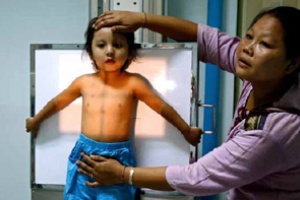World TB Day: Children with tuberculosis being failed
Much more needs to be done to prevent tuberculosis (TB) which affects at least half a million of the world’s children every year, with as many as 70 000 losing their lives. According to WHO and the Stop TB Partnership, most children can be saved from this curable illness with better diagnosis of the condition, greater access to health services and improved coordination of healthcare programmes.
One key area where such coordination is critical is in relation to HIV. Children living with the virus are highly vulnerable to TB infection given their compromised immune systems. HIV-positive people are 20 to 30 times more likely to develop tuberculosis, which is responsible for one quarter of AIDS-related deaths. The situation can be especially dangerous for children as TB is often not routinely considered as a possible diagnosis and can therefore remain undetected.
"We have made progress on TB. Death rates are down 40% overall compared to 1990 and millions of lives have been saved," said Dr Mario Raviglione, Director of the WHO Stop TB Department. "But unfortunately, to a large extent, children have been left behind, and childhood TB remains a hidden epidemic in most countries. It is time to act and address it everywhere," he added.
WHO and the Stop TB Partnership recognize that TB can be hard to diagnose, especially in developing countries where the method used to diagnose it—the analysis of a sputum sample—was developed 130 years ago. Nonetheless, a recent study in Bangladesh found that the detection rate of children with TB more than trebled when workers in 18 community centres received special training on childhood tuberculosis.
Addressing TB in children is relatively inexpensive. According to estimates, tuberculosis prevention for a child costs less than 3 cents a day and treatment around 50 cents a day.
Integrated services needed
Integration of maternal and child health services, HIV care and tuberculosis care to save the lives of children with TB is seen to be an absolute necessity, requiring bold political leadership. This is especially the case if the commitment made by countries in the 2011 Political Declaration on AIDS—to cut in half the number of deaths among people living with HIV by 2015—is to be realised.
According to WHO/Stop TB Partnership, all HIV-positive pregnant women, babies and children at clinic visits should be checked for signs of tuberculosis and given appropriate treatment if required. When detected in children living with HIV, TB treatment needs to begin immediately and, after two to eight weeks on such treatment, antiretroviral therapy (ART) should be started. Furthermore, relevant personnel need to be trained to check patients for TB risk, signs and symptoms and refer them for TB preventive therapy or TB treatment as needed.
Other recommendations to get to zero TB deaths among children are the inclusion of children and pregnant women among the participants of research studies on new TB diagnostics and drugs; more accurate national estimates of the number of childhood TB cases and deaths; and increased funding for TB diagnostics, drugs and vaccines.
According to Dr Lucica Ditiu, Executive Secretary of the Stop TB Partnership, the key to the ultimate goal of preventing TB deaths in children is for partners to work together to pinpoint those most in need: “Before we can give prevention or treatment we have to find the children at risk of TB, and this will only happen if governments, civil society and the private sector work together."


